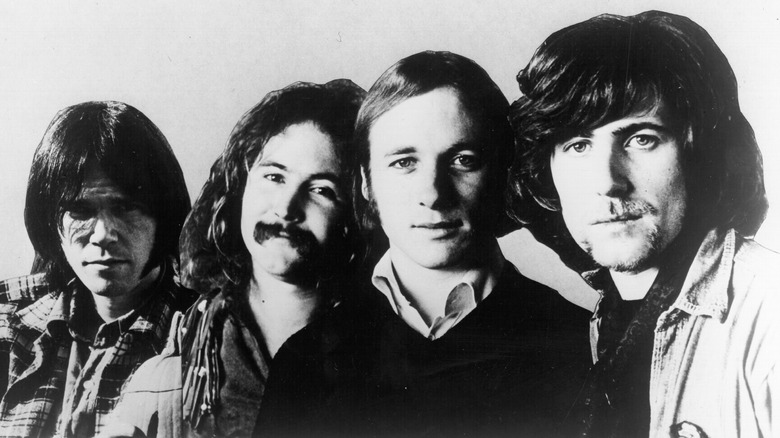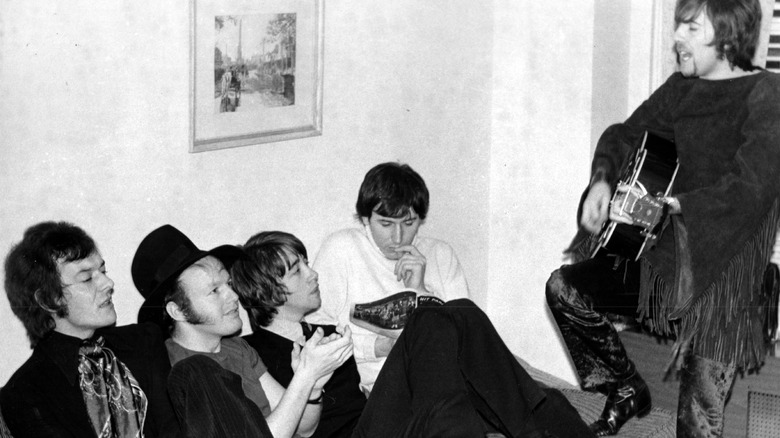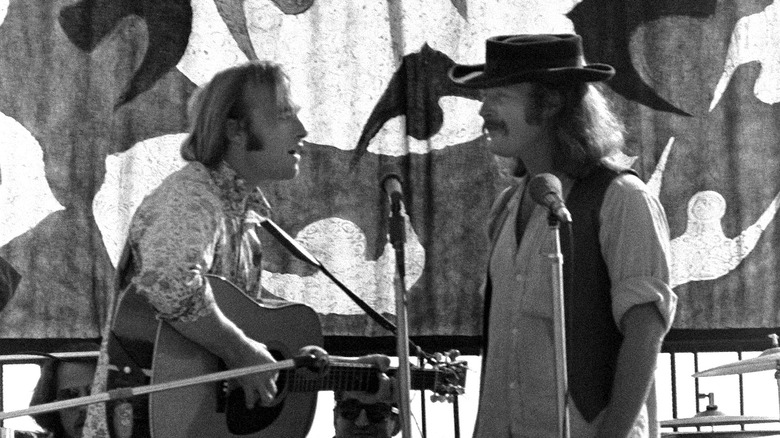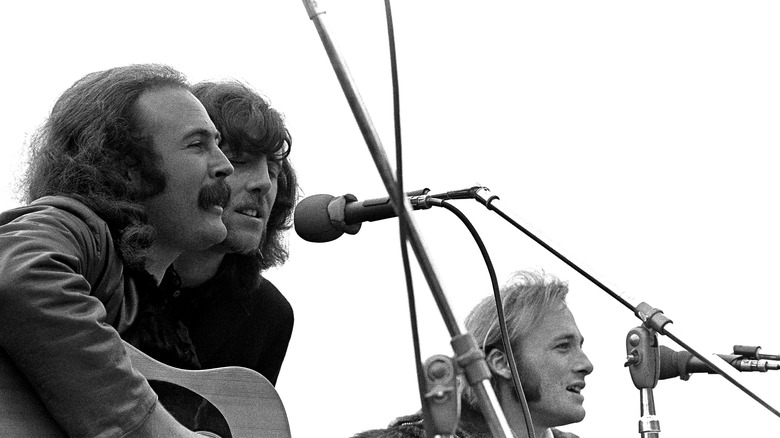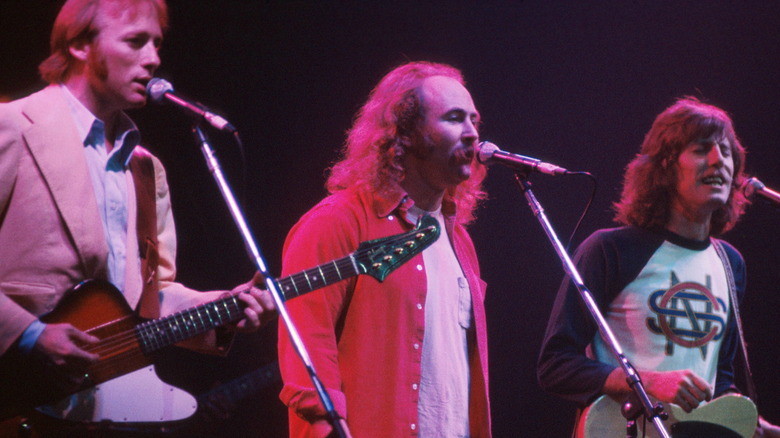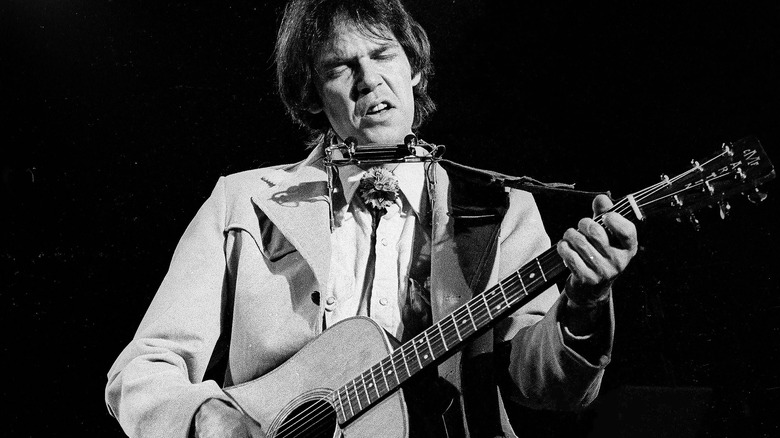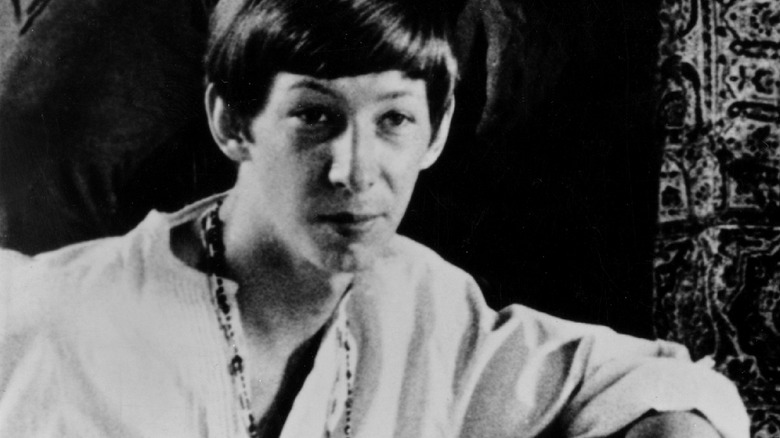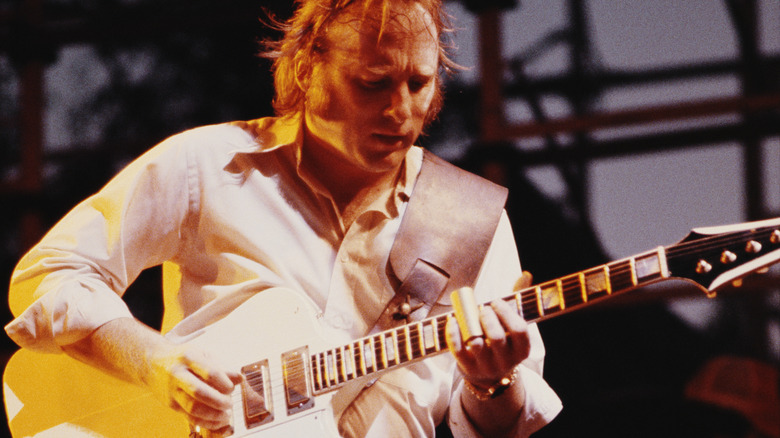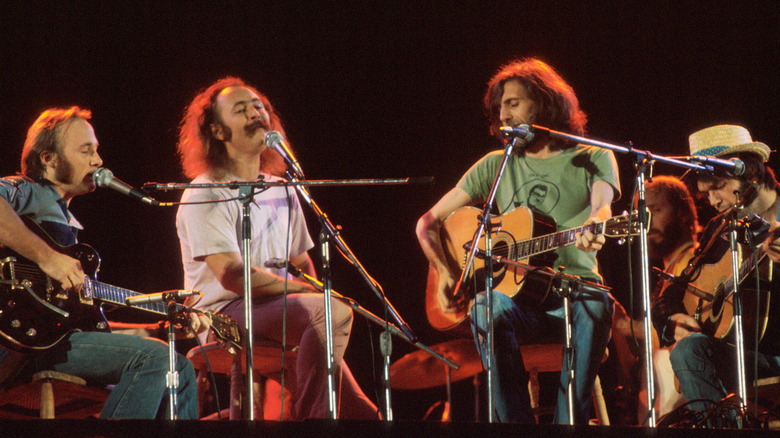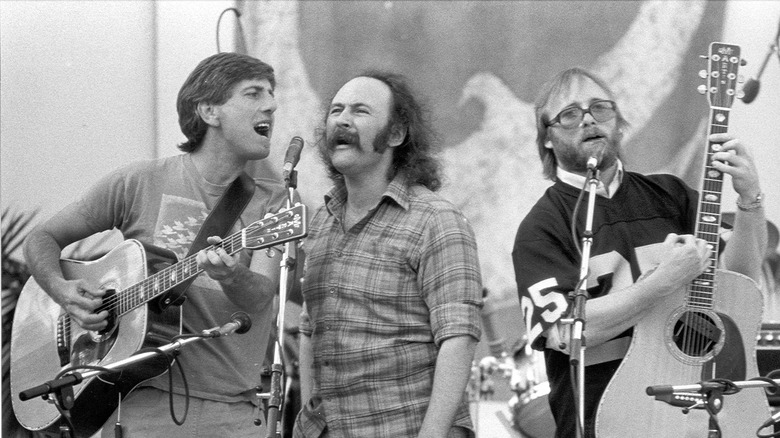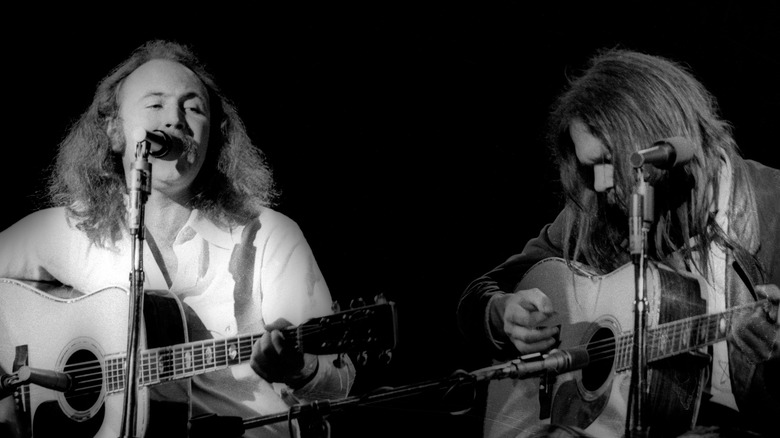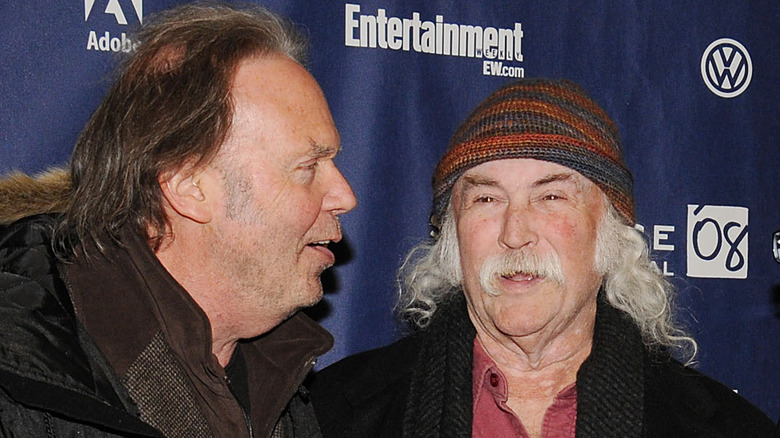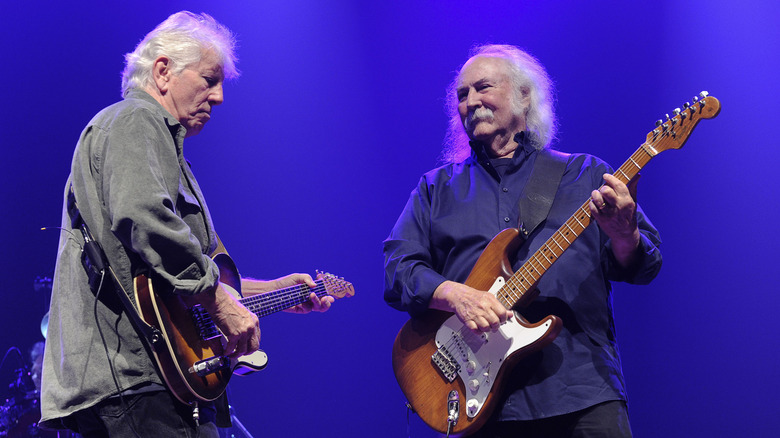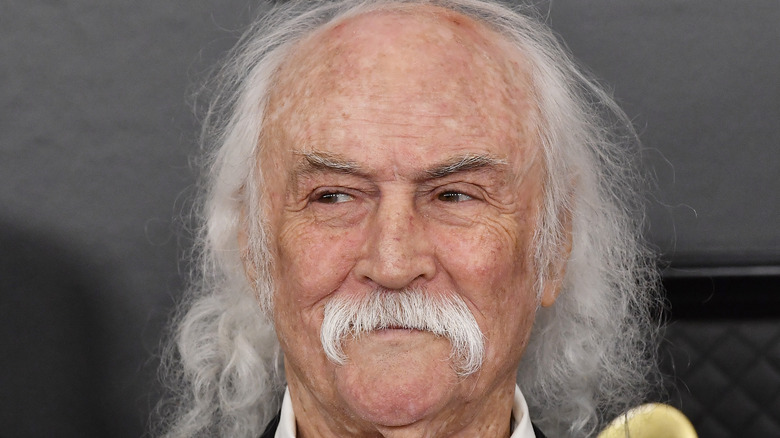The Tangled Story Of Crosby, Stills, Nash & Young
The hippy generation never lacked musical standard-bearers. The era that saw Woodstock was spoiled for choice on bands. But Crosby, Stills & Nash — later Crosby, Stills, Nash & Young — stood out even among their storied company. Pioneers of folk rock and one of the first notable supergroups, the sometimes trio, sometimes quartet marked a noted shift in the sound of rock. As noted by All Music, the output of the group in the 1970s illustrated a broad cultural retreat from exhibitionism into more thoughtful musical expression.
But the sound of CSNY, as they were often abbreviated, a particularly harmonious blend of the three-to-four voices and talents, was not matched by an easy rapport away from the microphone. David Crosby, Stephen Stills, Graham Nash, and Neil Young routinely butted heads during their time together, and their conflicts were exacerbated by heavy drug use, disparate aims, and egos (per Britannica). The supergroup came apart and put itself back together many times over the years, and a seemingly final divide between members became permanent with the death of Crosby in January 2023, per his Los Angeles Times obituary. Here is the tangled story of Crosby, Stills, Nash & Young.
Crosby, Stills, and Nash all came from other bands
A musical supergroup is the union of established talents. David Crosby, Stephen Stills, and Graham Nash were all known musicians by the late 1960s, each of them having been associated with a successful band in the United States or Great Britain. On the American side of the Atlantic, Crosby was a founding member of the rock group the Byrds, reconstituted from the Jet Set and the Beefeaters. Per Rolling Stone, it was Crosby's work that was central to the band's popular sound, but tensions led to its dissolution by 1967.
Stills had been a member of Buffalo Springfield since the band's inception after a traffic jam encounter in 1966 (per Britannica). It was a group not long for the world, splitting up only two years after coming together. But before then, Stills and his bandmates scored an era-defining hit with "For What It's Worth," and all were counted names of musical note when they went their separate ways.
Over in Britain, Nash spent the 1960s as a member of the Hollies, a musical group out of Manchester. They were still active by the time Nash encountered Crosby and Stills, and he told The Guardian years later that Nash's decision to leave the Hollies was a difficult one. "They were my friends for many, many years," he said of the Hollies, "But when I heard myself singing with David and Stephen that first time... I needed to sing those songs."
They all remember differently how they first played together
The founding members of Crosby, Stills & Nash all had run-ins with one another in the years prior to them becoming a trio. According to Dave Zimmer and Henry Diltz's "Crosby, Stills & Nash: The Authorized Biography," David Crosby and Stephen Stills were aware of one another when they became professionally associated following the break-up of Stills' band, Buffalo Springfield. Theirs wasn't a terribly professional association at first. Crosby describes them spending their days getting high and jamming, but they immediately found a musical rapport with one another. Graham Nash, speaking at the Hudson Union, remembered visiting America around the same time when he was introduced to Crosby by a mutual friend, and Stills through Crosby.
It wasn't long after that the three men first played together. But while all parties agree that their first time making music as a trio came at the end of the 1960s when they were at a house in Laurel Canyon, they don't agree on whose house it was. Per Vanity Fair, Stills insists that their virgin performance was at Cass Elliot's home. Crosby and Nash insist that it was at the home of Joni Mitchell, a claim she supports. Stills can't count on backup for his story, Elliot being deceased.
The trio were turned down by the Beatles' record company
The acrimony that Crosby, Stills & Nash is best known for is that between its members. Business, aesthetic, and personal conflicts disrupted their musical harmony for decades. But in their earliest days, the trio had beef, at least of a professional nature, with another, more famous group.
According to Dave Zimmer and Henry Diltz's "Crosby, Stills & Nash: The Authorized Biography," when David Crosby, Stephen Stills, and Graham Nash first decided to come together as a band, one of their first auditions was for the Beatles' Apple Records. Decades later, Crosby took to Twitter to say they had played an entire album's worth of content live for George Harrison himself. "After we finished," Nash said, "[Harrison] went, 'Wow!' Then he turned us down!"
Nash put the rejection down to British hostility toward American competition in the rock scene, but Apple passed on many acts. Per Far Out Magazine, fellow Brit David Bowie was also turned away. And years later, Nash said that Harrison had told him it was for the best. Apple was a disaster as a label and had CSN been signed by them, they very likely would have been lost amidst its myriad problems.
The name was deliberate in more ways than one
Some band names have private meanings, some are taken from animals or places, some are jokes, and some are straightforward. Crosby, Stills, Nash & Young is as self-explanatory as they come: the last names of the four featured players. It was a naming convention decided on from the beginning when the quartet was still a trio, and it came out of the experiences David Crosby, Stephen Stills, and Graham Nash had as members of bands with less specific names.
"[W]e were proud of ourselves and didn't want to get lost behind some dumb band name," Crosby was quoted saying in Dave Zimmer and Henry Diltz's "Crosby, Stills & Nash: The Authorized Biography." The band only existed because of the compatible voices and playing of its three members. Naming it so would not only declare the music as theirs, but it would also keep anyone from being easily replaced. As for the order of the names, Crosby disavowed any part in the choice. Nash appeared to take the credit, telling Zimmer and Diltz that Crosby, Stills & Nash offered the most pleasing rhythm and cadence. In this decision, at least, ego had nothing to do with it.
Crosby, Stills, and Nash all had reservations about accepting Neil Young
While Neil Young has been associated with Crosby, Stills, Nash & Young for almost the entirety of the band's lifespan, he's always been the most distant of its members. Over the decades, CSNY often returned to CSN as Young proved unavailable or unwilling to participate in tours or albums. His mercurial attitude toward work is a well-known trait of Young's, and it was among the reasons that his three bandmates all hesitated before bringing him aboard in the first place.
Stephen Stills had already been in a band with Young; they were both in Buffalo Springfield. There, per Observer, he'd had ample opportunity to experience Young's tendency to decide against performing at the last minute. While sanguine about such behavior in later years, in 1969 Stills looked far and wide for someone else when CSN decided they needed a fourth. According to Mojo, he approached Eric Clapton and the Beatles' George Harrison, among others.
When Young's name finally came under consideration, Crosby told the BBC, "We didn't — at first — want him. We knew that Buffalo Springfield had imploded." Apart from Young's behavior, there were issues of pride among the three bandmates to consider. "We're all crazy, egotistical musicians," Crosby said. "We're not easy to get along with." Young was eventually signed, for better or for worse. "It was like lobbing a hand grenade in a vacuum," Graham Nash told Mojo.
Their supporting players didn't last long
Their band's name ensured that David Crosby, Stephen Stills, Graham Nash, and sometimes Neil Young would always have a role to play so long as the band existed. And the sound of Crosby, Stills, Nash & Young was always primarily theirs. But there were other performers associated with the supergroup over the years, other musicians covering a part on tour or in the studio. Some of those performers didn't last long.
An early supporting player with CSN was Bruce Palmer, once a bandmate of Stephen Stills from their days with Buffalo Springfield (per Observer). But Palmer, who provided bass on tours, was a heavy drug user who began to behave erratically. Per Dave Zimmer and Henry Diltz's "Crosby, Stills & Nash: The Authorized Biography," he became disruptive during set-ups and once abandoned a show. His arrest and deportation on drug charges took him out of the lineup.
A similar fate was in store for another CSNY bassist, Greg Reeves. Per Zimmer and Diltz, there were drugs and strange antics behind his dismissal too, though Graham Nash named another issue: "Greg also wanted to sing some of his songs on the CSN&Y show, which I thought was ludicrous, only because the songs weren't good." Reeves' firing necessitated a last-minute replacement ahead of a tour, and the bassist hired — Fuzzy Samuels — was another associate of Stills, making songs written by Stills the most polished. This increased tensions among the name members.
Cocaine and egos fueled their first breakup
No one could accuse the members of Crosby, Stills, Nash & Young of false modesty. They've all been vocal over the years about their talents, collectively and as individuals. It's perhaps inevitable that such egos would butt heads when put together, and CSNY began seeing divisions almost from the beginning.
Speaking at the time of a 1977 reunion with Rolling Stone, David Crosby was open about his issues with Stephen Stills' ego. "He and I used to go nose to nose about once every 15 minutes," he said, while Graham Nash claimed that Stills shoved his and Crosby's songs off of the band's playlist. But aside from any ego drive, Stills' relationship with his bandmates was also complicated by his excessive drinking and drug use, which often left him incoherent.
Not that he was the only one indulging. Speaking to The Guardian in 2022, Nash blamed cocaine for stimulating the clash of egos in the first place. His reputation among fans was that of the relatively sober one tempering Stills and Crosby's appetites, but that wasn't quite true. In his memoir "Wild Tales: A Rock & Roll Life," Nash included himself among the members who were "coked out of our minds" during the recording of 1970's "Déjà Vu."
Their 1974 reunion was marred by drugs
Drugs loom large in the story of Crosby, Stills, Nash & Young. Graham Nash gave drugs praise and blame for various aspects of his own career and the trajectory of CSNY in an interview with The Guardian in 2022. But everyone involved with the band had their chance to indulge for good and ill. The presence of drugs, and cocaine in particular, was marked on a 1974 venture David Crosby later dubbed the "doom tour."
Per Rolling Stone, the tour represented the first reunion of CSNY after their first split four years prior. Everyone was well-supplied with cocaine and other drugs, carefully packaged to avoid customs agents. While Neil Young maintained some distance in a separate bus, Crosby, Nash, and Stephen Stills carried drugs and other vices to excess, justified at the time by a need to relieve the pressure of rock and roll careers at their peak.
Besides the drugs, large portions of the tour went unrehearsed as the four musicians wrote new songs and tried them out on the road. While this could be creatively stimulating for the band, a similarly lax approach to watching the money meant that a large chunk of the tour's gross was spent or taken by others. The music itself was often compromised by technical issues common to the era. And a feud between Young, Crosby, and Nash killed plans for a live album.
The trio reunited for nearly 10 years
When the 1974 tour by Crosby, Stills, Nash & Young finished, the foursome went their separate ways and attempts to reunite proved difficult. Per Rolling Stone, an effort instigated by Neil Young in 1976 turned into a project between himself and Stephen Stills, to David Crosby's great annoyance. "I have nothing but contempt for those two," he said at the time.
By the following year, Young was still out, but Crosby and Stills were prepared to mend fences. Graham Nash had remained connected with Crosby all the while. Crosby, Stills & Nash reformed as a trio and hit the road and the recording studio. The group continued on in that configuration for several years, and looking back in 2022, Nash told The Guardian he was more fond of the work done as CSN than that done as CSNY.
But while CSN managed to stay together for an extended period, tensions between members remained. Nash explained that he and Stills' competition for the heart of Rita Coolidge from earlier in the band's history was in part to blame for the band's first breakup. (Coolidge insisted this love triangle wasn't related to the breakup to People.) Regardless, tension was still there after the reunion, but it took a back seat to Crosby's escalating drug use, and the two were prepared to continue without him according to Crosby's memoir "Long Time Gone."
Young promised to rejoin if Crosby sobered up
David Crosby's drug use plagued Crosby, Stills & Nash through the late 1970s and the early 1980s. Things came to a head in 1983, when Crosby was arrested on drug and weapons charges and sentenced to five years in prison (per The Guardian). While he initially fled state lines, Crosby ultimately surrendered, serving five months before parole. He declared himself drug-free on release and set about reuniting with his bandmates (per the Los Angeles Times). That included Neil Young, who had long been absent from the group. But a backstage encounter before Crosby's incarceration had left an impact on the prodigal player. According to Peter Doggett's "CSNY: Crosby, Stills, Nash and Young," Young made Crosby an offer: If he cleaned himself up, Young would rejoin.
The full reunion of CSNY had only a modest impact. By this point in their careers, all the members were part of an aging and increasingly nostalgic generation. Their first album after Young's return, "American Dream," didn't make waves. And Young's return proved only temporary. By 1990, per All Music, it was back to CSN again, although Young would periodically come back during the decade for certain tours and records.
Crosby and Young fell out in the early 2010s
Age did nothing to soothe the tempers that often plagued relations between members of Crosby, Stills, Nash & Young. Well into the 21st century, they found things to fight about. In 2014, just a year after CSNY's last tour, Neil Young was asked at a concert about the next one. "CSNY will never tour again, ever," he replied (via Rolling Stone), "but I love Stephen Stills."
At least one reason for Young's firm no to future tours, and his leaving David Crosby out of his fond feelings, came from Crosby himself. Speaking on The Howard Stern Show the following year, he offered an apology for comments he made about Young's girlfriend, Daryl Hannah, and offered well wishes to Young. Crosby was in a less conciliatory mood when he spoke to The Guardian in 2021. While repeating that he was in the wrong to insult Hannah, he had no good word for Young. "[Neil is] probably the most self-centered, self-obsessed, selfish person I know," Crosby said. "He only thinks about Neil, period."
Crosby and Nash fell out in the late 2010s
While Crosby, Stills, Nash & Young seemed to definitively end in 2013, Crosby, Stills & Nash endured another two years. But by 2021, David Crosby told The Guardian that Stephen Stills was the only member of CSNY he remained in contact with. Crosby and Graham Nash, who had long been the member closest to Crosby, finally had it out. "Graham just changed from the guy I thought was my best friend to being a guy that is definitely my enemy," Crosby said.
Nash had his own words to say on the matter to The Guardian the following year. Acknowledging as well that they had once been best friends, Nash insisted the acrimony was Crosby's fault. "[W]hen he goes on social media, says I wasn't his friend, and all I was in it for was the money, that's absolutely heartbreaking for me." He was firm that any potential reconciliation was not in the cards.
Crosby had alienated more than CSNY by the end of his life. In its obituary for him, the Los Angeles Times noted that his former bandmates from the Byrds were also estranged. But it also noted that Crosby's many Twitter followers never stopped asking about a reunion of CSNY, which Crosby never completely closed the book on before his death.
Stills, Nash, and Young still honored Crosby after his death
The prospects for another Crosby, Stills, Nash & Young reunion were very slight at the end of 2022, with David Crosby alienating himself from two out of three bandmates (per The Guardian). His death on January 18, 2023, closed the door for good. But despite the acrimony they'd experienced with Crosby over the years, all of the surviving members of CSNY paid him a moving tribute.
Graham Nash, whose falling out with Crosby was particularly public and harsh, took to Instagram to say farewell. "People tend to focus on how volatile our relationship was at times," he wrote, "but what has always mattered to David and me more than anything was the pure joy of the music we created together... and the deep friendship we shared over all these many long years." Stephen Stills issued a statement of condolences on Twitter and offered a more personal statement to Rolling Stone in which he said he and Crosby had been "at peace."
Neil Young had his own words to offer on his website. He described Crosby as the heart and soul of CSNY and praised his songwriting, singing, and playing. He ended with a declaration that he would only remember the good experiences they'd had together.
